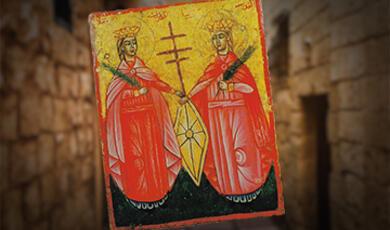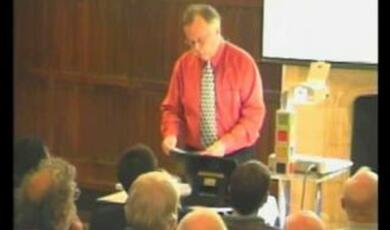Disease and Death in Late Stuart London
Share
- Details
- Text
- Audio
- Downloads
- Extra Reading
A specialist in British and European History, Maureen Waller's books includeUngrateful Daughters: The Stuart Princesses Who Stole Their Father's Crown and1700: Scenes from London Life.
Download Text
Disease and death in late Stuart London
Maureen Waller
If you were sitting here in this parish in William III’s London in the late seventeenth century you would be aware of noises and smells largely absent today.
The first of these was the almost constant ringing of church bells, more specifically the passing bell, which might sound many times a day to denote the death or imminent death of parishioners. The bell tolled nine times for a man, six for a woman and three for a child, followed by a brief pause and then a chime for each year of the person’s age. The passing bell acted as a reminder to the living bustling about their daily business that ‘the beating of thy pulse is just the tolling of thy passing bell.’
The words of the Anglican burial service – ‘in the midst of life we are in death’ – never rang so true as in this age of high mortality. The death rate among people of all ages was higher than it had been a century earlier. London – with a population of just over half a million by the end of the seventeenth century – could not sustain itself. In any year there were more burials than christenings. London relied on a steady stream of robust young migrants and about 8000 a year from all parts of the kingdom poured into the capital, lured by the prospect of wages higher than anywhere else. Daniel Defoe rightly described London as a consumer of people.
About one third of the population died well under 50. Husbands lost young wives, children their mothers – very often in childbirth - and mothers frequently lost their babies. One in three babies died before the age of two. Only one in two of the survivors passed the age of fifteen. An epidemic might wipe out several children in a family within days. Thousands of adolescents failed to reach adulthood. Adults in their twenties and thirties – often family breadwinners – were surprisingly vulnerable. Sickness was a constant presence in every home. Death struck swiftly. A fever in the morning could mean death by the evening. Something that we would take in our stride, such as a cut or a broken limb, could mean death in days from septicaemia or gangrene. Death was never far away. Medicine was powerless to prevent it.
The second sensation you would be aware of in late seventeenth-century London was the smell of the place. Travellers approaching the capital would be warned of their imminent arrival by the overwhelming stink, largely thanks to the mounds of sewage and other waste dumped by the night-soil men on the roads leading into town. It was so bad that it was imperative to hold a handkerchief to the nose and mouth. In the city itself, streets and ditches were awash with human excrement and urine, while sheep, cattle, pigs and poultry were led through the muddy streets to slaughter, adding their excrement to that of the horses. In the houses, sewage vaults overflowed into neighbours’ cellars – as Samuel Pepys recorded on one occasion when he found himself ankle deep in turds from next door. Cesspits leaked into wells and contaminated the water supply.
John Evelyn warned of the threat to health from London’s overcrowded graveyards, where ingenious methods had to be employed to squeeze in more bodies. In the parish of St Martin in the Fields comprising a mere 26 acres, for example, there were nearly 16000 burials in the last decade of the century, an annual average of 1400. Large deep burial pits for paupers, such as the one in Tottenham Court, were left open until they received their full complement of bodies. Imagine how foul the air smelt in that neighbourhood. Evelyn writes:
‘I am persuaded, that the frequency of churchyards and charnel houses contaminate the air … as well as the pumps and waters, which are near unto them, so that those pipes and conveyances which pass through them (obnoxious [prone] to many dangerous accidents) ought either to be directed some other way, or very carefully to be looked after.’
Apart from the smells, there was the all-pervasive, sulphurous coal smoke which belched out of thousands of domestic chimneys and industrial furnaces. It played havoc with King William’s asthma, forcing him to live out of town at Kensington and Hampton Court, but all Londoners were affected by the pollution. Evelyn noted that in any London gathering there was constant coughing and snuffling, barking and spitting – ‘the spittle, and other excrements which proceed from them, being for the most part of a blackish colour.’ Those in the vicinity of a consumptive’s phlegm in such a gathering would be treated to a host of airborne bacilli. Not surprisingly, tuberculosis, or consumption, was one of the biggest causes of death in London.
In this unhealthy environment an attempt was made to identify and record the causes of death in the bills of mortality – in due course, someone as far- sighted as Sir William Petty would promote their use as an index of public health, so that steps could be taken to protect the community. At this early stage, however, even the medical profession had trouble in defining a disease, plague and smallpox being the only two recognised for certain. Physicians, who ministered mainly to the wealthy, were not obliged to issue a death certificate. As the ‘searchers’ employed by the parishes were poor, ignorant lay women who gave the deceased only the most cursory examination and relied on hearsay and guesswork, the bills offer only a rough guide. The equation of their findings with our definitions of sickness and disease can only be tentative.
There were the diseases Londoners lived with – chronic, debilitating and disfiguring. And there were the diseases that killed them. The fact that the role of hygiene and of germs, or organisms, was not understood meant that the medical profession was far from being able to tackle the fundamental problems.
The low standard of personal hygiene meant that fleas and lice were commonplace, even on the bodies, wigs and clothing of the wealthy. They were blissfully unaware of the connection between plague, rats and fleas – the latter apparently carrying the deadly plague to humans after leaving their original host, the dying rat. After the plague of 1665, London rats seem to have become plague resistant. Coincidentally, the plague-carrying black rat was in the process of being overtaken by a new species of brown rat. At any rate, there would be no more outbreaks of plague in London, although no one realised this for some considerable time. As late as 1720 when plague broke out in Marseilles, Londoners panicked. It was no wonder, therefore, that Defoe’s A Journal of the Plague Year, published in 1722, found such a receptive audience.
Contaminated food and drinking water caused frequent outbursts of bacterial stomach infection. Flies travelled from faeces to food. It did not occur to those preparing or handling food to wash their hands after defecating. The bills of 1700 recorded only those cases that proved fatal, rising to a peak in the heat of August. They were colourfully described as ‘Griping in the guts’, ‘Twisting in the guts’, ‘Bleeding, bloody flux and flux’ and ‘Looseness’. Dysentery killed within hours or days. Infants were highly vulnerable. Diarrhoea might be accompanied by high fever leading to convulsions. Many deaths occurred because there was no understanding that severe diarrhoea required a replenishment of liquid and salt in the body.
It is unlikely that people actually died of ‘worms’, despite the 53 cases listed in the bills of 1700. But as their eggs might be relayed repeatedly into the mouth from unwashed hands, worms could be a long, debilitating condition. Intestinal worms were especially common in children. It is probable that tapeworms were frequently transmitted from undercooked beef and pork. We know from Pepys’ diary that meats brought in from the cook-shops – the contemporary take-away – were frequently found to be undercooked. Tape worms from pork could pass into the brain and be responsible for epileptic fits, described in the bills as the ‘falling-sickness’.
Other stomach disorders might be attributed to overindulgence in food and drink – listed in the bills as ‘Surfeit’ – and to an unbalanced or inadequate diet. The wealthy ate too much meat and scorned vegetables. Good living and a tendency to drink large quantities of alcohol rather than the contaminated water led to gout with its painful swollen big toe. The eminent physician Sir Thomas Sydenham suffered from the condition himself and wrote a paper on it:
‘The gout most commonly seizes such old men as have liv’d the best part of their lives tenderly and delicately, allowing themselves freely banquets, wine, and other spirituous liquors: and at length, by reason of the sloth that always attends old age, have quite omitted such exercises as young men are wont to use.’
The strange sounding ‘dropsie and tympany’ in the bills described swellings from excessive fluid retention.
Of course, rotten or missing teeth, a common problem in the population at large, did not aid the digestion. ‘Teeth’ is given as a cause of death in the bills and probably refers to teething infants whose solicitous mothers have rubbed a dirty coin across their sore gums to ease their suffering – unwittingly causing infection and death.
Scurvy with its swellings, sores and ulcers was called ‘the disease of London’. John Woodall, the first surgeon-general of the East India Company, astutely recommended the juice of lemons as a preventive, but this was not adopted until the end of the eighteenth century. St Bartholomew’s Hospital used spoonwort growing on the banks of the Thames to make scurvy-grass ale for scurvy sufferers.
Children of all classes suffered from rickets, through deficiency of Vitamin D, essential for the absorption of calcium. There was little chance of Vitamin D being generated by the sun’s rays in London ’s dark rooms and polluted atmosphere. Lack of calcium and other minerals led to skeletal deformity. Girls with pelvic deformity would later suffer and probably die in childbirth, where a prolonged labour often led to the mother being literally bumped up and down in a blanket in a vain attempt to make the baby come out.
The bills of mortality bear witness to the high incidence of women dying in childbirth, and of those who succumbed to other infectious diseases after being laid low by it. In general there were 23.5 maternal deaths per 1000 baptisms. Over her whole childbearing span of about 20 years, a woman had a 6-7% chance of dying in childbirth. Annual pregnancies were typical, especially in upper class women who did not breast feed, or in the London women whose husbands wanted to get them back into the shop or other business as soon as possible after childbirth. The future Queen Anne, for instance, had 17 pregnancies in as many years. Maternal mortality varied from parish to parish. It was not necessarily the rich who survived. Many poor women fared better simply because they dispensed with the sometimes disastrous interference of a midwife. However, the incidence of puerperal fever was lower than it was to be after the establishment of the lying-in hospitals in the eighteenth century, when a whole ward full of women might be affected. Many women who did survive the ordeal of childbirth were so badly damaged that they suffered from embarrassing conditions such as incontinence for the rest of their lives.
A constant stream of small babies regularly left London for the countryside, where they were farmed out to wet nurses. The air was healthier for them, but they were often victims of neglect, ignorance and dirt. Inevitably, a huge proportion of these babies died.
The King’s Evil, or scrofula, described in the bills as ‘Swelling in the neck’ or ‘Evil’, was tuberculosis in the lymph glands of the neck, transmitted to humans in cows’ milk. All previous monarchs had adhered to the old superstition of touching to cure the condition. As with so many instances of magical healing, the power of suggestion was probably at work – or else the illness had gone into abeyance. Only the rational and dispassionate William III, who knew he owed his crown to Parliament rather than divine right, refused to touch for the evil, telling his disappointed subjects: ‘God give you better health and more sense!’
The bills list ‘ague and fever’ – malaria, borne by mosquitoes breeding in marshland and stagnant water in ditches – as one of the highest causes of mortality. Meningococcal meningitis, listed as ‘Spotted fever and purples’, was common in crowded conditions such as prisons. Typhoid from contaminated drinking water was often confused with typhus, because of the rash and fever that could occur in both diseases. Typhus, otherwise known as gaol-fever because of the prevalence of this louse-borne infection in overcrowded prisons, had first been identified and recorded in the garrisons during the civil war. Judges and juries were exposed to the disease and it was for this reason that Newgate had an outdoor courtroom and judges kept nosegays on the bench in a vain attempt to ward off the contagion. It was quite common for a prisoner in the dock to be ‘seiz’d with a jayl-distemper … and so not in a capacity to give any account of himself.’
There was a virulent new strain of smallpox – called smallpox to distinguish it from the great pox, or syphilis. Smallpox – a virus inhaled from the exhalations of people incubating the disease or transmitted through contact with the pox pus or scabs of the sufferer -- was highly contagious among London ’s closely packed population. It was no respecter of rank, killing Queen Mary II at Christmas 1694. Thousands of migrant workers who had never been exposed to it in the countryside and had no immunity to it inevitably succumbed soon after arriving in London. Those who survived were usually left with facial scars and disfigurement for life. This led to the fashion for wearing black patches on the face, which English women did to excess, whether they were scarred or not.
Venereal disease, which seems to have been rampant, was considered a social disgrace and relatives went to considerable lengths to persuade the searchers not to put down what they called ‘the French disease’ or ‘pox’ as the cause of death. As the searchers almost certainly took bribes not to name the dreaded disease, it is reasonable to assume that VD was far more widespread than the figures in the bills allow. Men went for purging or sweating treatments in the bagnios or baths in the Covent Garden area, so that these gradually became places of ill repute.
As Londoners were chronically ill, they were easy prey to any who promised a cure. They spent a fortune on medical treatment and there was a booming market for do-it-yourself home medical books. They could buy drugs over the counter at the apothecary’s shop without prescription. Cannabis was freely available like any other drug, although the home medical books warned that too heavy use of it would lead to impotence in men. The physicians, apothecaries, barber-surgeons and quacks who preyed on them realised there was a lot of money to be made from the desperate and gullible. The wit Tom Brown suggested in his Amusements Serious and Comical that a wise man should steer clear of a greedy medical profession who had a vested interest in over-prescribing:
‘When a sick man leaves all for nature to do, he hazards much; when he leaves all for the doctor to do, he hazards more; and since there is a hazard both ways, I would much sooner choose to rely upon nature. For this, at least, we may be sure of, that she acts as honestly as she can, and that she does not find her account in prolonging the disease.’
Needless to say, with such a ready market for their services, the various branches of what may tentatively be called the medical profession were in fierce competition with each other. The College of Physicians was fiercely jealous of its privileges, claiming the sole right to diagnose and prescribe medicines. After all, its members had spent 14 years in the Universities of Oxford and Cambridge acquiring the necessary classical education to enable them to study Hippocrates and Galen, upon whose theories the practice of medicine was still based.
In practice, the physicians were far outnumbered by the apothecaries and barber-surgeons and had no hope of servicing half a million sickly and hypochondriac Londoners by themselves, even if they felt disposed to get up and attend a sick patient in the night, which they did not. In 1700 there were 60-80 physicians and about 1000 apothecaries in London. The pretensions of the physicians were a cause for scorn and amusement. It had not been forgotten that many of them had abandoned Londoners to their fate during the plague of 1665, following their rich patients to Oxford and the countryside. In spite of their pretensions, they were hardly more successful than anyone else in curing disease. Tom Brown was scathing:
‘These gentlemen of the faculty are pensioners to death, and travel day and night to enlarge that monarch’s empire; for you must know, notwithstanding distempered humours make a man sick, ‘tis the physician has the honour of killing him, and expects to be well paid for the job … So that when a man is asked how such a man died, he is not to answer, according to custom, that he died of fever or a pleurisy, but that he died of the doctor.’
The physicians regarded the Members of the Worshipful Society of the Art and Mystery of the Apothecaries of the City of London as mere tradesmen. Originally members of the Grocers’ Guild, who stocked and sold spices, the apothecaries had won the sole right to dispense and sell medicines in London. Apothecaries served a 7-year apprenticeship, accompanying their master to attend sick patients and observing the physician at work, learning to make up the physicians’ prescriptions in the shop and making occasional excursions to the country to gather herbs. He might study botany at the Chelsea Physick Garden. The physicians argued that there was more to the practice of medicine than merely watching and copying them.
The public perception of the physicians was that they were too expensive, but it was difficult for them to reduce their fees without diminishing their worth in the public eye. The apothecaries were more accessible – if not actually cheaper in the long run -- and they and the punters saw no good reason to keep the physician in the loop.
The barber-surgeons did not escape the physicians’ censure, although ironically their study of anatomy was giving them a far more practical knowledge of the workings of the body than the physicians could draw from their reliance on ancient texts. The Royal College of Physicians and the Worshipful Company of Barber Surgeons were allowed a maximum of ten corpses a year from the gallows on which to practise anatomy. As London’s many criminals were resigned to dying but not resigned to having their bodies cut up after death – supposedly hindering resurrection on the day of Judgement – there were violent scenes on execution days, fights between the mob and those sent to secure the corpses. In the accounts at the Barbers Company today you will see carefully listed the expenses involved in this exercise: ‘Paid the beadles for being beat and wounded at the late execution £4.4s’ … Paid the high constable of St Giles’ parish for assisting the beadles in recovering a body which had been taken from the beadles by the mob 7s 6d’ … ‘Paid to bring a skeleton from St Giles’ to the hall in a coach 2s’.
The Worshipful Company of Barber-Surgeons consisted of the barbers and the surgeons, each of whom was to keep to his separate part of the business. An eminent London surgeon such as Joseph Binns always began his treatment with the administration of an emetic, a purgative and an enema to clean out the stomach and bowels and set the body on the path to healing itself. According to the precepts of Galenic medicine that were still current, an individual’s mental and physical condition was believed to depend on the balance of the humours. The four humours or bodily fluids – blood, phlegm, yellow bile and black bile – corresponded to the four elements of earth, fire, air and water, whose qualities were dryness, heat, cold and wetness. An imbalance of the humours caused dis-ease.
As excess humours must be evacuated to restore the body to equilibrium, surgeons were busy with traditional treatments of bloodletting, cupping and blistering. For instance, the body of a woman whose periods had stopped was considered to be awash with ill humours, which would affect the brain and cause melancholy. Blood would be drawn from her foot to ‘bring down the menses’. Just to be on the safe side, many people elected to be bled once a year as a spring clean, whether they were ill or not. As the need for sterilisation was not understood, they risked infection from the surgeon’s unclean hands and tainted instruments.
It was particularly tragic that in such a pugnacious society, when Englishmen were quick to draw the sword, surgery was limited to the most superficial of operations, so that penetrating wounds usually proved fatal. A broken limb needed to be amputated immediately to prevent the onset of gangrene. It was possible to cut for the stone or renal calculus – Samuel Pepys had had a successful operation and showed his friends a stone as big as a tennis ball to prove it. The removal of an appendix or a gall-bladder was beyond the surgeon’s scope. Superficial tumours could be removed, and a mastectomy was possible. The art of plastic surgery, pioneered by an Italian in the sixteenth century, was used to conceal the effects of a nose eaten away by the pox. Carrying out an operation on a table in the patient’s home and relying on alcohol to render the patient senseless, the best surgeon was a speedy worker.
The barber shops catered for blood letting, the extraction, cleaning and scraping of teeth, nail paring, ear waxing, shaving and wig making. They offered tobacco to cure toothache, as well as condoms and sexual advice. It was they rather than the physicians, therefore, who acquired a virtual monopoly of the treatment of venereal disease, through administering mercury by mouth and applying it in ointments to rashes, scabs and ulcers and by injection to the nose and genitals. It relieved the symptoms, when unfortunately many assumed they were cured and went on to transmit the disease to young wives or other women.
In this volatile market a whole army of quacks thrived, selling supposed cures. Newspapers, the walls of coffee-houses, even the Royal Exchange were littered with their advertisements. Excessive claims were made for the efficacy of their cures. It was often the poor, who could least afford it, who were persuaded to part with their money on these useless remedies.
The sick Londoner confined himself to his chamber at home – out of necessity, since treatment was designed to rid the body of its ill humours by constant vomiting and purging – and was nursed by the women of the household or hired nurses. Free health care was limited to the aged poor. The hospitals which survived the dissolution of the monasteries in the sixteenth century – St Bartholomew’s and St Thomas’s – were there to serve their needs alone and to provide them with beds as much as treatment. Nursing was indifferent and filth and infection rampant. Bethlehem Hospital in Bishopsgate, known as Bedlam, was reserved for the ‘distracted and lunatick’. A visit to Bedlam to watch the antics of the insane was considered a good day out for Londoners, while a profusion of new private asylums was growing up as much for men eager to lock away unwanted wives as for the truly insane.
In late seventeenth-century London, life might truly be described as a mere prelude to death. It was a social and religious duty for all to visit the sick and pray with the dying. Regular attendance by relatives, friends and neighbours – children included - at death beds and funerals bred resignation in the face of death. It reminded all to hold themselves in daily expectation of their own demise and to make spiritual preparation for it. Even in this more secular age, diaries record frequent self-examination of the soul, a desire to keep one’s relationship with God fresh and immediate. People clung to the idea of the after-life.
Yet in this post-Reformation world there was a lingering anxiety at the loss of Purgatory. The living were no longer able to relieve the dead of their sins by saying masses for their souls. This powerlessness translated itself into elaborate funeral rituals to assuage the grief of those left behind. A spiritual need became inextricably linked with materialism. Funerals, like the medical profession, became big business. The Gov was not slow to reap its share: it stipulated that any corpse not buried in a woollen shroud – to boost the national industry - would incur a £5 fine: government inspectors were sent round to ensure a corpse was probably attired and issued a certificate before the funeral could go ahead. There was also a 4s burial tax.
Funerals were an important indicator of the wealth and status of the deceased and his family, so that no expense was spared to impress mourners and the neighbourhood. Funeral tickets adorned with leering skeletons, scythes and admonitions such as ‘Remember to die’ would be left at the houses of those invited to the funeral. It was de rigueur for mourners to view the body and offer condolences to the family. The widow, wearing her black mourning with peaked headdress symbolic of her retirement from the world, received visitors in a darkened room in a house draped in black. Even babies would be wrapped in black crepe. All reflective surfaces such as mirrors had to be covered or turned to the wall, as this was a vulnerable time for the soul. Glittering jewellery could not be worn for the same reason. In wealthy households ceremonial mourners would be hired to look suitably doleful. Mourning rings with inscriptions – reminders not just of the deceased but of what was to come for all - were widely distributed.
It was fashionable to hold funerals in the evening. This meant that the undertakers profited from the extra expenditure on heavy wax torches. On at least one occasion they excited a robbery at the funeral – the mourners were literally mugged for their wax torches. The procession, with the mourners carrying rosemary for remembrance, was supposed to take the most direct route to the church, but it was tempting to impress the neighbourhood by taking the long way round.
The prevailing fashion for the wealthy was to be buried in the vaults of the church itself, which was pretty unpleasant for the worshippers during the time they were decomposing. Otherwise, there was much jostling for the best place in the churchyard – certainly not on the north side, which was reserved for suicides, felons and un-baptised babies. Suicide, incidentally, was deemed to be on the increase. It was certainly very common. A Swiss visitor, who found London’s dark skies depressing, commented that if he were an Englishman he too would probably commit suicide. The perception that it was on the increase, however, was probably attributable to the burgeoning newspaper industry, who reported details of each suicide with relish. The Church still reserved the right to refuse a suicide a Christian burial.
To return to the funeral, graves were priced accordingly. It was customary to bury the corpse face up in a grave oriented east-west, so that he was ready to rise up on the day of judgement. Flowers placed on the grave represented the green symbols of rebirth. Only by the late seventeenth century were tombstones being used to mark graves in churchyards.
After the mourners had thrown their rosemary into the open grave the funeral procession returned in the same order to the house, where the will was read to the assembled family and friends and the drinking took place. The Frenchman Henri Misson was amazed at how much alcohol English women managed to put away:
‘Such women in England will hold it out with the men, when they have a bottle before them … and tattle infinitely better than they.’
There are many bizarre aspects of life and death in late seventeenth-century London, but I leave you with one extraordinary image. Women routinely held their children up to the gallows, to have them stroked by the hands of the executed criminals as a general guarantee of good health. The bodies of the executed were believed to contain mystical properties, in much the same way as the monarch was supposed to have the healing touch.
© Maureen Waller, Gresham College, 18 October 2004
This event was on Mon, 18 Oct 2004
Support Gresham
Gresham College has offered an outstanding education to the public free of charge for over 400 years. Today, Gresham College plays an important role in fostering a love of learning and a greater understanding of ourselves and the world around us. Your donation will help to widen our reach and to broaden our audience, allowing more people to benefit from a high-quality education from some of the brightest minds.


 Login
Login







